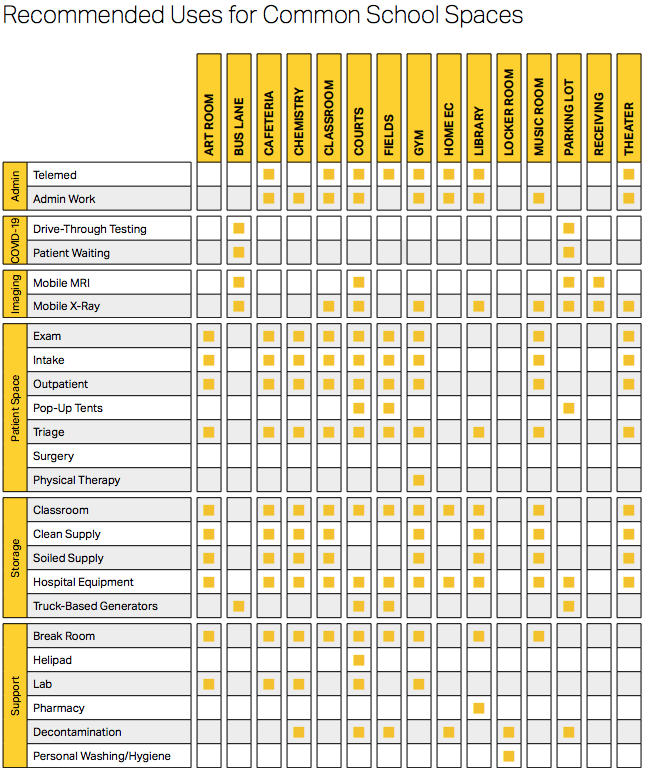By Bob Erickson and Eric Thomson for Corgan
Already pressed for capacity, COVID-19 has ushered in an unprecedented demand on our healthcare spaces — spotlighting our dependency on these delicate ecosystems and our need for sustainable, creative solutions that support this critical infrastructure.
As experts in healthcare and education design, Corgan tapped its internal research and development team and engaged partners Henderson Engineers and Rider Levett Bucknall to explore ways to expand the bandwidth of our healthcare systems. These investigations provide insight into the compatibility of education spaces and a case study on retrofitting schools into Temporary Hospital Centers to serve patients not requiring treatment for COVID-19.
COVID-19 has pushed the limits of healthcare spaces. Prioritizing resources for those fighting the virus, healthcare is short on staff, supplies, resources and space to care for the long string of other patients that still require access to care.
The impact of the pandemic reaches far beyond those infected with the virus — crippling the resources and capacity for hospital care available for those seeking short and long-term treatments, needing emergency attention, or making a routine visit. From broken arms and the routine flu to surgeries and preventative screenings, the need has not slowed; instead, healthcare operations and design have been challenged to quickly adapt to new processes and unconventional spaces to meet demand.
Military ships and convention centers across the country have been converted into care facilities. As the nation collectively tries to flatten the curve while keeping otherwise healthy patients safe from the virus, designers have an opportunity and challenge to quickly scale healthcare spaces and prepare those communities hardest hit by the global pandemic.
Elementary schools and educational facilities offer several advantages for a quick transition to Temporary Hospital Centers. Corgan’s designers studied the potential of these currently empty and underutilized facilities to better serve the highest and most timely needs of the community.
Transforming these spaces into Temporary Hospital Centers provides safer spaces to care for non-COVID-19 patients — distancing them and their family and caretakers from the virus, mitigating exposure and reducing risk.
Hyperlocal, schools anchor communities. They are deeply embedded in the fabric of each town and provide natural existing access points. Relieving pressure from primary hospitals, staff, and resources can concentrate on and reserve efforts for treating patients with COVID-19 while also providing an outlet for others in a safer, contained environment.
A Corgan case study taps into several compatibilities of schools as Temporary Hospital Centers, including:
- Infrastructure: While the power and Wi-Fi needs for Healthcare requirements are going to be specific to each community, most schools generally have adequate power and Wi-Fi to accommodate high demands and needs. If additional electrical power is needed, it can be easily supplemented with added mobile generators to provide a required redundant resource.
- Room sizing and zoning configuration: Schools typically have 20-30 classrooms at 800-900SF per class, which can be quartered-off to serve multiple patient beds and other identified needs, such as Triage rooms, Geriatric care, Gastrology, Urology, ENT, Obstetrics, Gynecology, Minor Emergency rooms, etc. Many schools separate into wings that are each mechanically zoned, which is favorable when in need of a sterile environment.
- Campus assets and amenities: School grounds can be used for Triage Tents to increase the level of care. Parts of the school, such as gymnasiums and libraries, could be utilized as daycare units for the healthcare workers. Kitchens and cafeterias can be used for food prep to feed all occupants, as well as a place to store local food deliveries.
- Traffic and flow patterns: District bus systems can be used for transporting healthcare staff and patients to and from designated areas. Schools are designed to accommodate drop-off and pick-up traffic, material delivery and food preparation.
- Community connection: Neighborhood schools connect with the local community and keep long-distance travel and congested roads to a minimum.
Extrapolating on the potential of these foundational advantages, Corgan’s study provides a model to quickly convert local schools into Temporary Hospital Centers to manage cases displaced by COVID-19 in as little as 15 days — providing communities a safer and healthier space to treat their non-COVID-19 patients with minimal-to-no reconstruction.
Read the full case study here.

